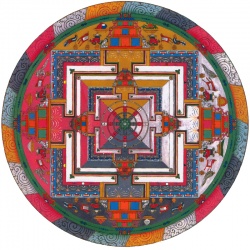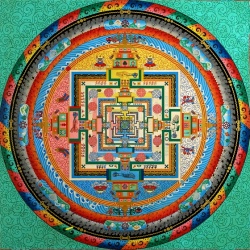About the Kalachakra Mandala
A Few Notes About the Kalachakra Mandala
The body of written wisdom reflecting upon mandalas and Tibetan Buddhist sand mandalas in general, and the profound Kalachakra Mandala in particular, is substantial.
What is a mandala, and what is the Kalachakra mandala?
One wonderful introduction to the subject might be the book, The Wheel of Time: Sand Mandala, Visual Scripture of Tibetan Buddhism, by Barry Bryant (1940 - 1997), written in cooperation with Namgyal Monastery.
(Snow Lion Publications) Ven. Losang's own well-worn copy can be seen in some of the photographs in our Kalachakra photo galleries. (And indeed, images of Losang himself, as well as his work, can similarly be seen in some of photographs in the book.)
The following excerpts are reprinted from this highly informative, colorful, and very readable work.
The Mandala
The Tibetan word for mandala is kyilkor, which means "center and surrounding environment."
The mandala of a tantric deity [in this case, the Buddhist deity, Kalachakra] includes the deity and his palace, which is also a representation of the mind of the deity.
Based on symbols familiar to the people of India during the Buddha's lifetime, each mandala is a pictorial manifestation of a tantra. It may be "read" and studied as a text, memorized for visualization during meditation, and interpreted.
The most commonly known mandalas are depicted in two-dimensional form, showing a floor plan - like a blueprint - of the three dimensional palace of the deity, including the architectural design and the many decorative details. Every component is a symbol representing an aspect of the teaching.
The purpose of a mandala is to acquaint the student with the tantra and the deity and to allow the student to "enter into the mandala"; that is, to enter into the state of being in which the deity dwells.
The Kalachakra Tantra
Kalachakra (in Tibetan Du kyi khorlo) is a Sanskrit word that can be translated literally as "wheel of time."
Kala, or "time," is not linear time but the flow of all events, past, present, and future.
This is similar to our concept of space, which does not imply a particular direction or limitation.
The Kalachakra deity represents omniscience, for he is one with all time and therefore knows all.
Chakra, meaning "wheel," refers not only to the cycle of time but also to the way in which the enlightened experience of great bliss radiates like the sun from the self to all sentient beings.
The wheel, with no beginning and no end, is also the universal symbol of Buddhism, representing the teachings of the Buddha. ...
The Kalachakra Sand Mandala is a visual representation of the entire Kalachakra Tantra.
It is also a two-dimensional representation of the five-story palace of the Kalachakra deity, in which a total of 722 deities reside, with Kalachakra and his consort Vishvamata united in an embrace of perpetual bliss at the very center.
A Teaching for Our Time
On of the important features of the Kalachakra Tantra is that it is given for a community. The Buddha offered it for an entire country, the mythical kingdom of Shambala, so historically the initiation has been given to large groups.
The Dalai Lama has remarked that in earlier times communities were separated by valleys, rivers, mountains or oceans, whereas today, with instant communication and transportation, our community includes the entire planet.
This is another reason why he feels Kalachakra is a teaching for our time.

